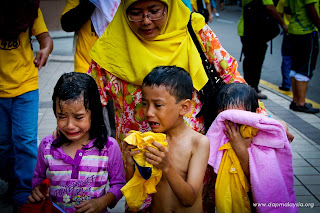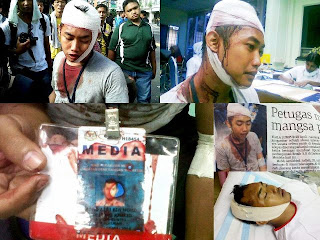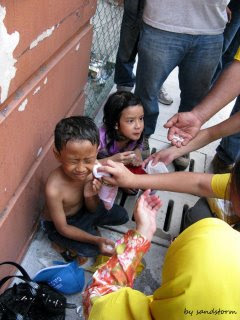In my five years as a journalist I've never felt more concern, anger, fear and a multitude of emotions while covering a single assignment than on that fateful Saturday when covering Bersih 3.0. I am writing this to highlight most of what I saw and heard on how the police conducted themselves towards the media during the Bersih rally as their actions call for a serious review on PDRM to avoid such incidents ever occurring in the future.
I was given a free role to roam about to any location during the rally but choose to be close to Dataran Merdeka as I anticipated that area to have the most activity as I anticipated the Bersih and other political leaders to give their speeches.
From my experience covering Bersih 2.0 last year and the Petrol Price hike protest in 2008, I had a feeling the event may end up with tear gas, water cannon, arrests and etc. As such from 12.30pm onwards I chose to go behind the police barricade and be where the uniformed policemen were stationed as we overlooked the crowds packed on the Jalan Tun Perak - Jalan TAR - Jalan Parlimen intersection area.
After the crowds broke through barricade at 3pm, I saw the cops run back about 100m to their awaiting FRU personnel and I, too did not waste a second to follow them as well as I expected the water cannons and tear gas will soon be unleashed on the crowd. Within a few minutes when most of the policeman were close to the FRU personnel, the water cannons were fired. Minutes later, tear gas too was fired at the crowd.
Now, from here onwards, began the danger, threat, assault and abuse experienced by the media personnel including me.
After the tear gas and water cannons stopped temporarily, I saw uniformed cops rush out to chase and apprehend the protestors along Jalan Tun Perak (near Masjid Jamek area). Those arrested were lead back to the Selangor Club where they were being held and possibly be processed before sending them to the temporary detention centre at PULAPOL. I use the word possibly because I was barred entry to the area where the arrested were being detained.
Not being able to get close to that area to find out roughly how many people had been arrested I turned back and was walking to the point the barricade was broken down by the protestors while seeing more people being led by police towards the detention center. But something caught my eye among those being arrested.... A cameraman I recognised who works at a Chinese daily! As I observed and tried to catch what was being said between him and the cop for the next few seconds. I heard him saying in an almost pleading voice that he had run into some building with protestors when the tear gas was fired and was finding his bearing when he got caught. But the cop just didn’t seem to pay heed and continued to lead him towards the detention centre.
Using my own compact camera I tried to snap pictures and videos of those being detained. Quite a number of the younger protestors were being held and pushed along roughly by the police while there were several times I saw protestors who had blood streaming down their face.
When I arrived at the intersection where the barriers were initially broken through by the crowd, I saw more people being rounded up as well as the first of numerous incidents where the protestors were being assaulted by the cops in numbers. Several videographers and cameramen tried to record and snap some photos but a few policemen told us and even shouted at us to stop and put down our equipment. A few more attempts to use my camera to capture video of the arrests were met with a similar response of NO.
Around 4pm I tried to make my way towards the Masjid Jamek LRT station but I was stopped by the police and met with shouts of “balik lah” and warned to put away my camera.
On several occasions, I saw policemen without their Velcro name tags on their uniforms. Only later upon interviewing a photographer colleague of mine, did I figure out why perhaps their name tags were removed.
My colleague said he was snapping photos of cops arresting some protestors at the Masjid Jamek LRT area who were being arrested while being bashed up by a group of policeman who had removed their name tags likely in a bid to avoid identification by the victims (protestors).
One policeman spotted him taking the photos and asked if he was a police photographer but replied that he was from the media. Within a dozen seconds or so, he was surrounded by five uniformed and non uniformed cops and demanded him to hand over his camera. The only thing that saved his equipment from being seized was that he offered to format his memory card in front of them. Despite formatting his memory card, the cops demanded he format another time, only then did they let him go. My colleague did however see a policeman from a distance grabbing a person’s camera, dismantling the camera lens from the camera body and smashing the lens on the ground on the ground before walking away as the man stood in complete shock. My colleague was unsure though if that person was a member of the press.
Another pixman colleague of mine said he was surrounded by over 10 cops at around 7.30pm at the Masjid Jamek LRT area after he was spotted taking photos of police arrests. One of them kicked his leg and another stopping several inches from punching him in the face in an act of intimidation. They demanded for his camera but he said it belonged to his company and cannot hand it over to anyone. They continued to abuse and harass him with one of them dangling a handcuff in front of him and threatened to arrest him. It was in this tense moment when one of them smashed his camera against a wall which resulted in the camera lens being badly cracked. They only left him once they took away his camera memory card.
When he asked why they were doing this to him, one of them shouted back that they heard that three of their cops had died during clashes with protestors. My colleague reasoned that this rumour had perhaps fuelled the cops to become more violent and abusive to any of the Bersih protestors and media personnel they saw loitering in the area where the cops were stationed and arrests were being made.
Flashback
From my perspective in Bersih 2.0 last year, the cops rarely told the media to stop taking photos or video. Sure, they shouted at us to get back or to not interfere with their work. But for us media personnel in Malaysia, we are quite used to that.
My opinion is that the free flow of photos and videos during that rally led to a lot of bad publicity against the cops. Perhaps in a way, to control or limit the number of such images being posted on the web and Youtube , etc the cops had been given instructions to not allow the media to record them while making arrests. But I also believe that no specific instructions were given on how to follow this directive and as such, may have led to the extreme measures used to stop the media from capturing the images and videos.
Why the extreme measure?
There are various other journalists and photographers, even those from foreign news agencies who had complained that their equipments were smashed, seized, arrested, verbally and physically abused, assaulted, kicked, punched, stepped on, pushed, shoved and etc, etc.
Were we, members of the media throwing bottles at the cops? Were we taunting and hurling abuses at the cops? Were we the ones responsible in breaking down the barricade? Were we the people who overturned a police car and etc etc.....
Surely the answer to all the above is a resounding NO. Then in that case, why many members of the media suffered an unprecedented level of aggressiveness from the cops?
I thank God that I personally did not suffer any of the ill fate that fell on other numerous media personnel but I am incensed to hear that such incidents had occurred to my colleagues and other media personnel. Sure, compared to the hundreds of media personnel on duty that day only, only a small number came out saying they were physically and verbally abused, but it was the previously unseen and shocking level of abuse that has raised many concerns and questions.
I am glad that the National Union of Journalists (NUJ) has taken a strong stand on this matter and its secretary general V. Anbalagan had called for a probe and explanation by the Inspector General of Police. Even more hearting is a unified call by various media outlets also condemning the rough action on the media.
There are many other horror stories that journalists, photographers and videographers had to endure during the Saturday rally which I am not able to relate in full here but what I have done is merely highlighting the sudden strong arm tactics employed against the media in the recently concluded Bersih 3.0.
On a final note, the purpose of this letter is not to paint a picture that the Malaysian Police force are all bad as I believe we have an effective and efficient crime fighting force as I have worked with them on countless times and have seen the numerous successes they have achieved in combating crime in this country over the years. But this latest incident unfortunately has left a lot to be desired of and I hope the top brass of the police force and the Home Minister set in place a proper ground rule on the police handling of the media and likewise in the future so that we never see a repeat of such incidents.
Sincerely,
Steven Daniel
A NUJ union member attached to The Star.



